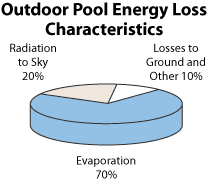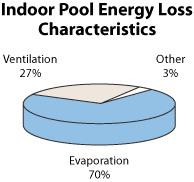
MINIMISING HEAT LOSS IN SWIMMING POOLS
Swimming Pool Covers
You can significantly reduce swimming pool heating costs by using a pool cover.
Use of a pool cover also can help reduce the size of a solar pool heating system, which can save money.
How They Work
Swimming pools lose energy in a variety of ways, but evaporation is by far the largest source of energy loss. Evaporating water requires tremendous amounts of energy. It only takes 1 Btu (British thermal unit) to raise 1 pound of water 1 degree, but each pound of 27ºc water that evaporates takes a whopping 1,048 Btu of heat out of the pool.

The evaporation rate from an outdoor pool varies depending on the pool's temperature, air temperature and humidity, and the wind speed at the pool surface. The higher the pool temperature and wind speed and the lower the humidity, the greater the evaporation rate. In windy areas, you can add a windbreak—trees, shrubs, or a fence—to reduce evaporation. The windbreak needs to be high enough and close enough to the pool that it doesn't create turbulence over the pool, which will increase evaporation. You also don't want the windbreak to shade the pool from the sun, which helps heat it.
 Indoor pools aren't subjected to the environment, but they still can lose a lot of energy from evaporation. They even require room ventilation to control indoor humidity caused by the large amount of evaporation. The ventilated air also must be conditioned, which adds to the energy costs.
Indoor pools aren't subjected to the environment, but they still can lose a lot of energy from evaporation. They even require room ventilation to control indoor humidity caused by the large amount of evaporation. The ventilated air also must be conditioned, which adds to the energy costs.
Pool covers minimize evaporation from both outdoor and indoor pools. Covering a pool when it is not in use is the single most effective means of reducing pool heating costs. Savings of 50%–70% are possible. Pool covers on indoor pools not only can reduce evaporation but also the need to ventilate indoor air and replace it with unconditioned outdoor air. You can also shut off exhaust fans when an indoor pool is covered, which saves even more energy.
Types of Pool Covers

Technically, all you really need for a pool cover is a large sheet of plastic. Plastic meets the requirement of being a vapor barrier. But a large sheet of plastic that you get from the lumber store is probably not your best choice. It will be very difficult to handle and store, it tears easily, and sunlight will deteriorate it rapidly. You can use a sheet of plastic, but it will be very inconvenient and it will probably only last 1 to 2 seasons maximum.